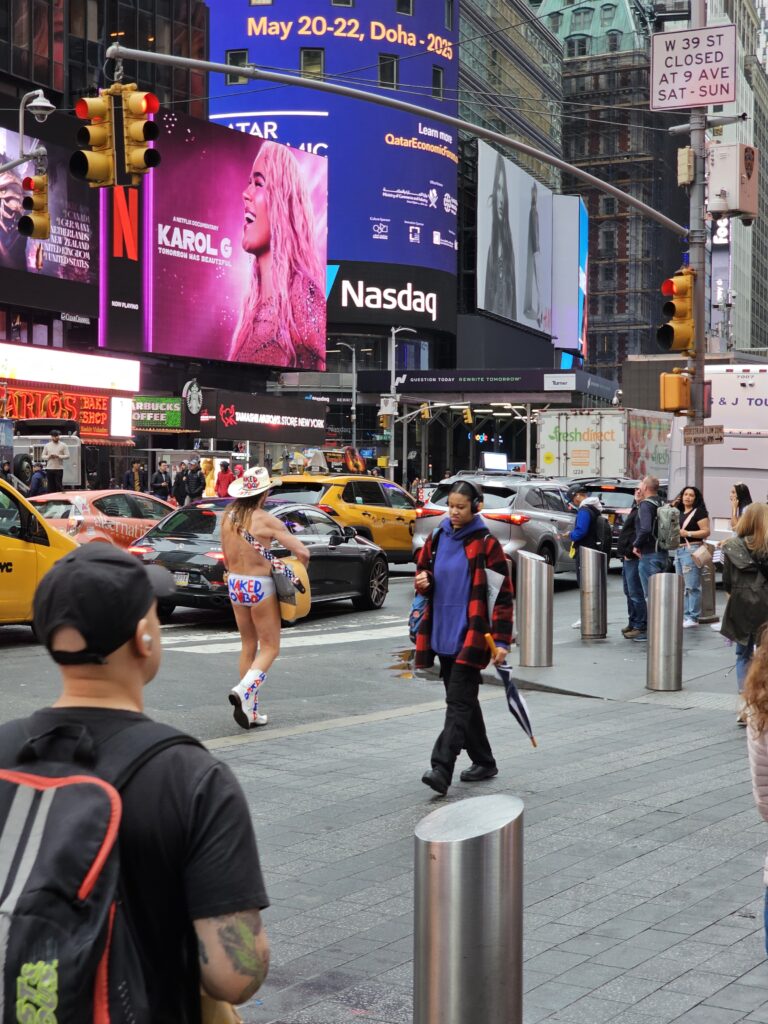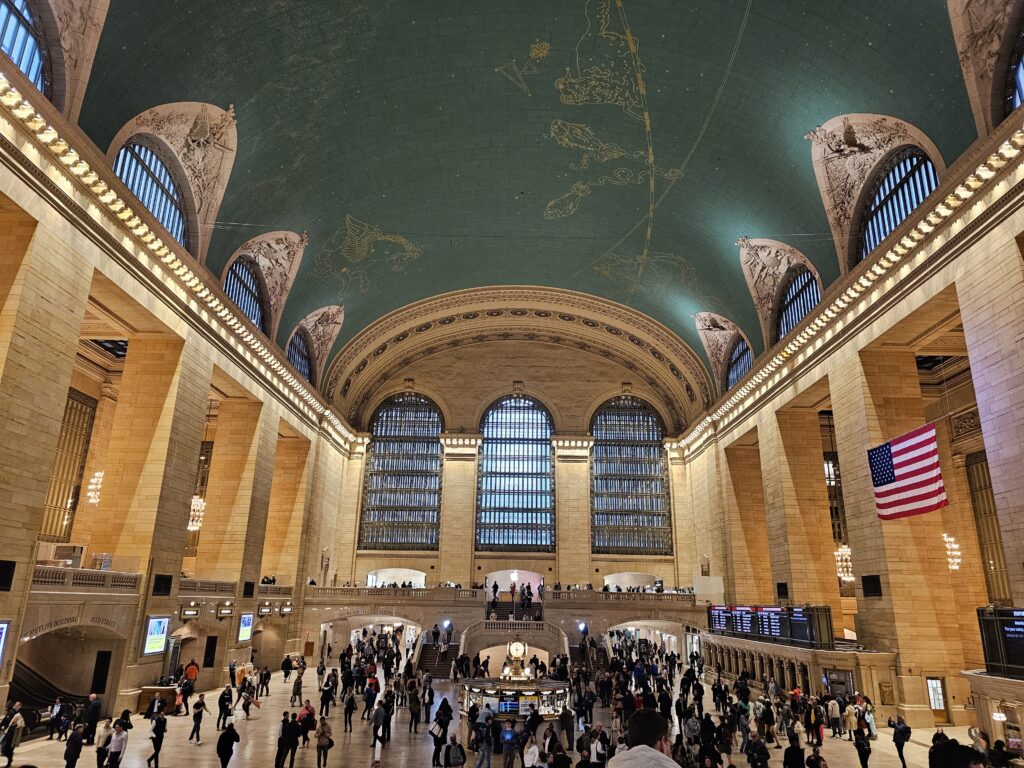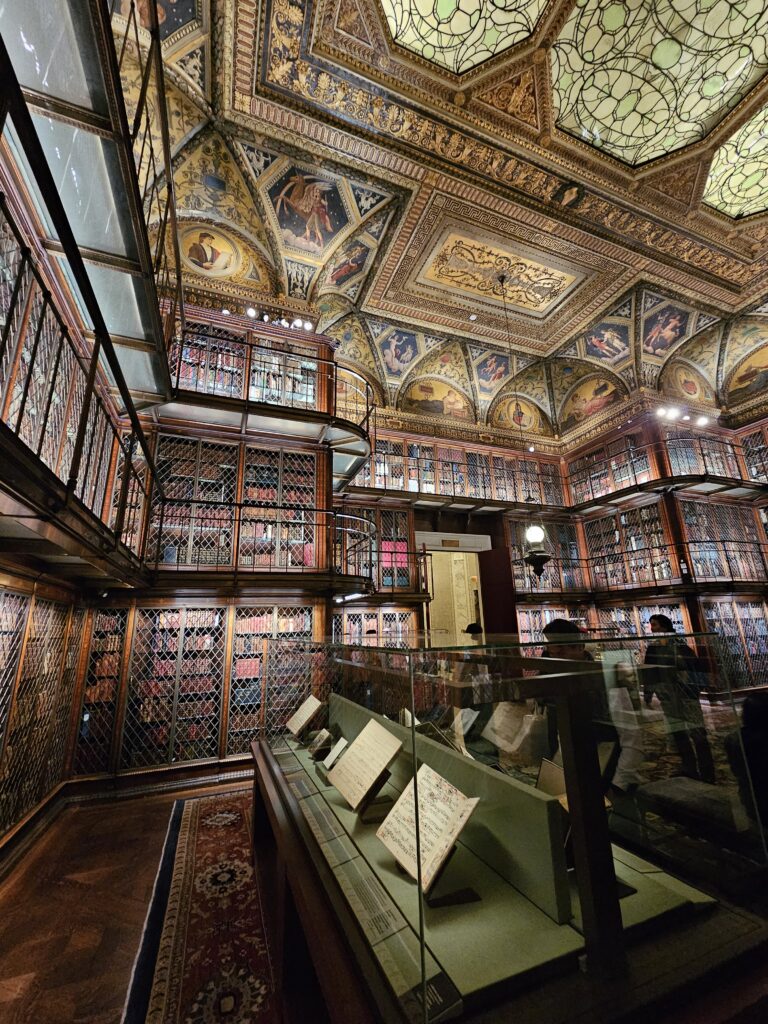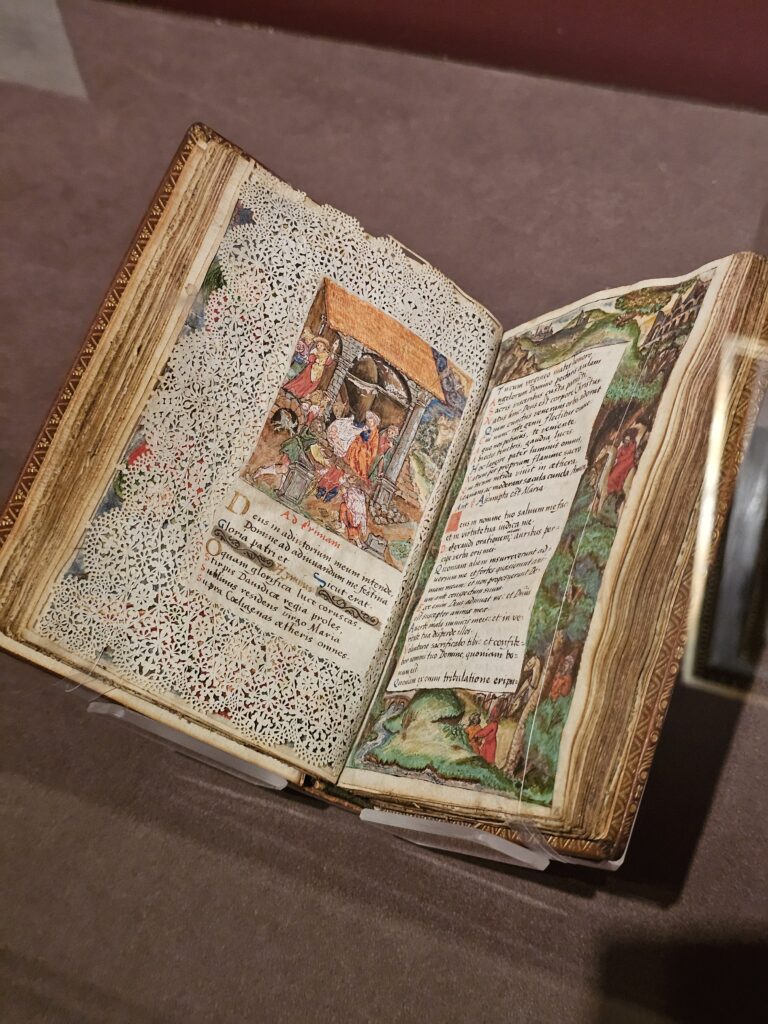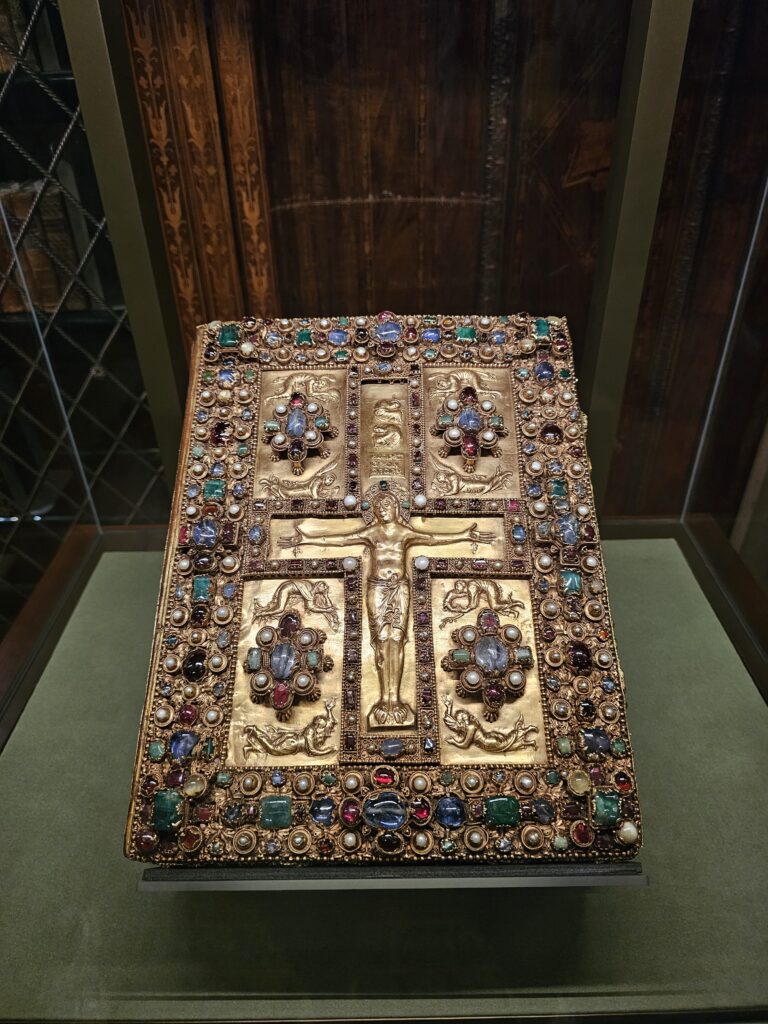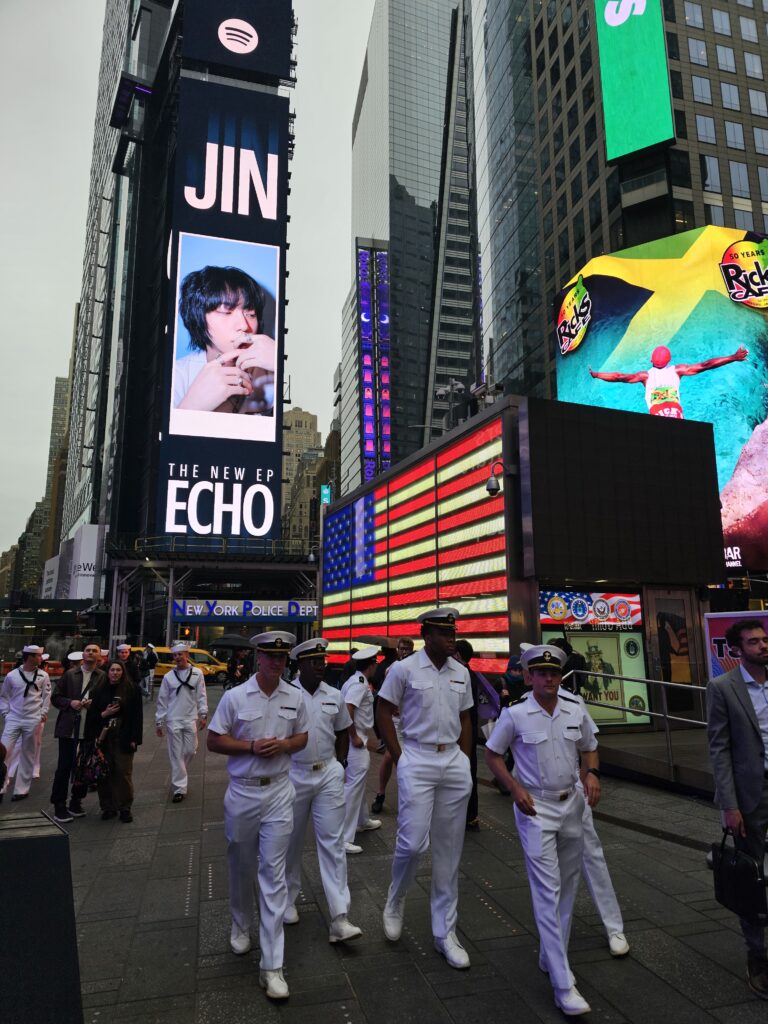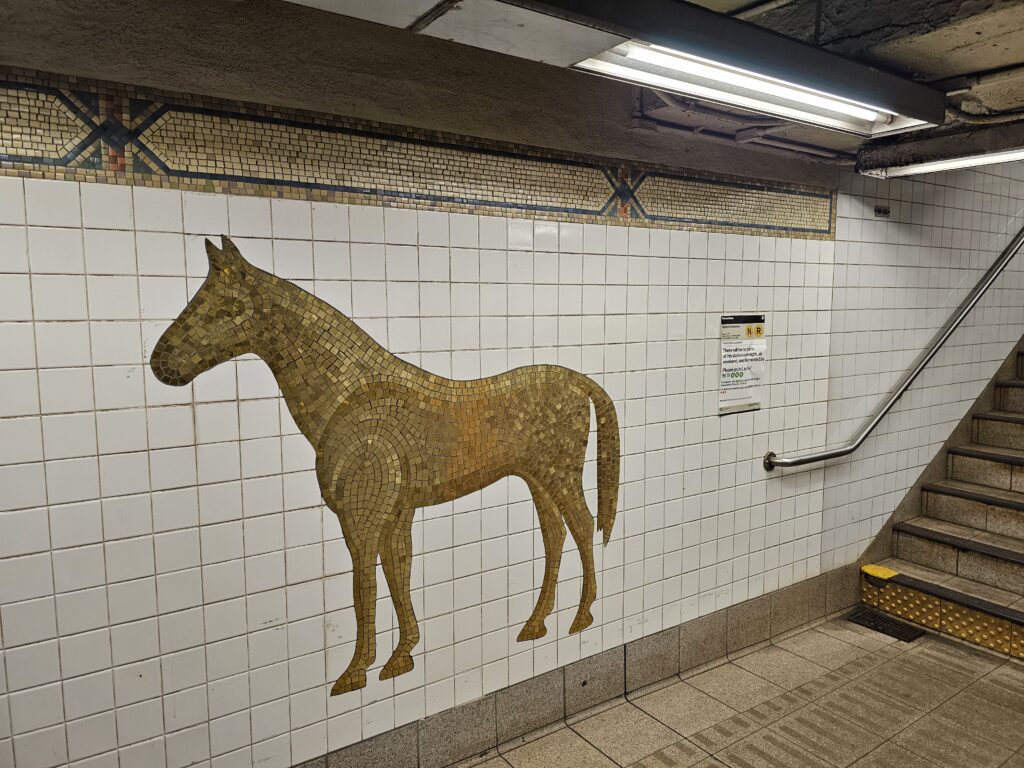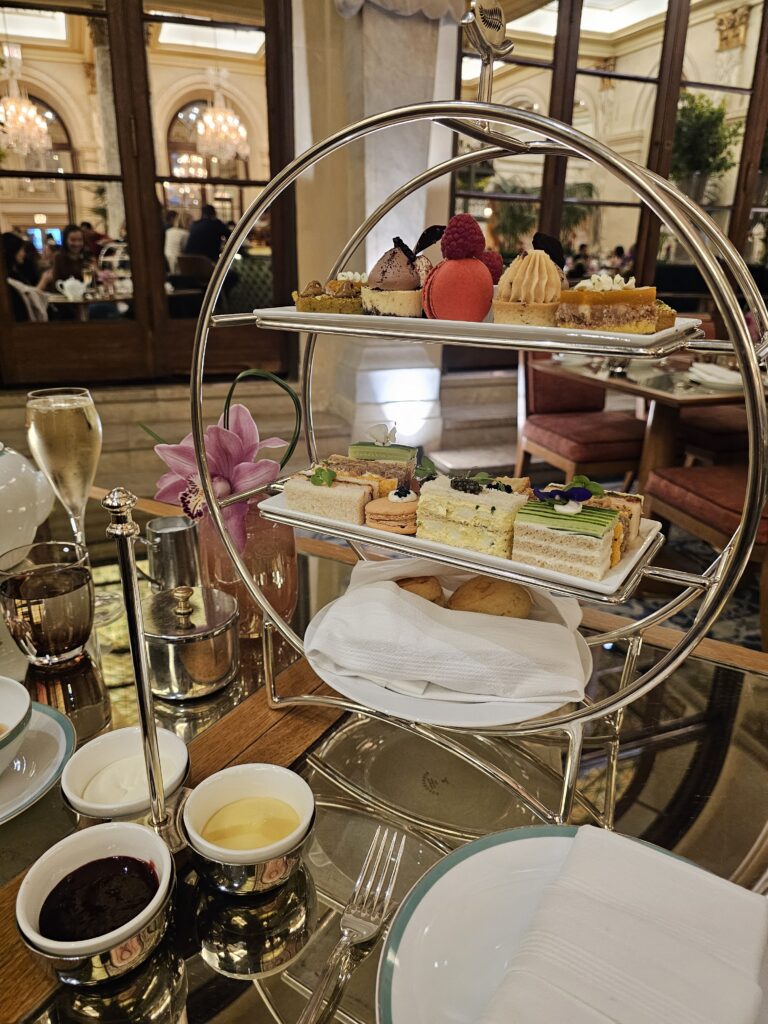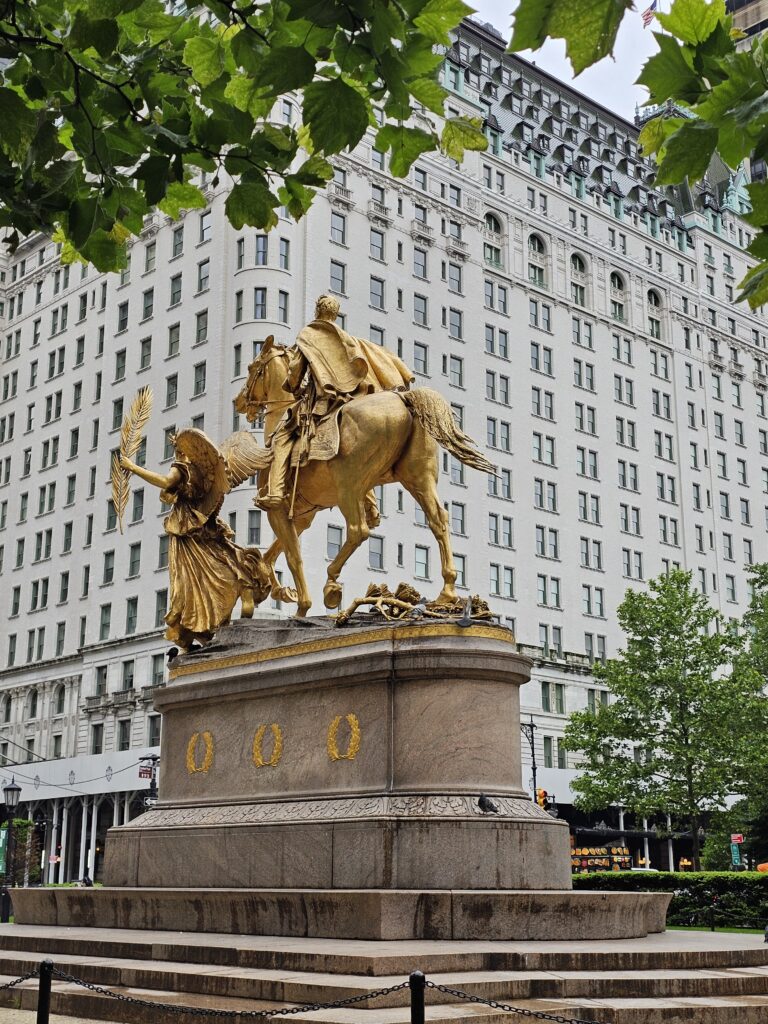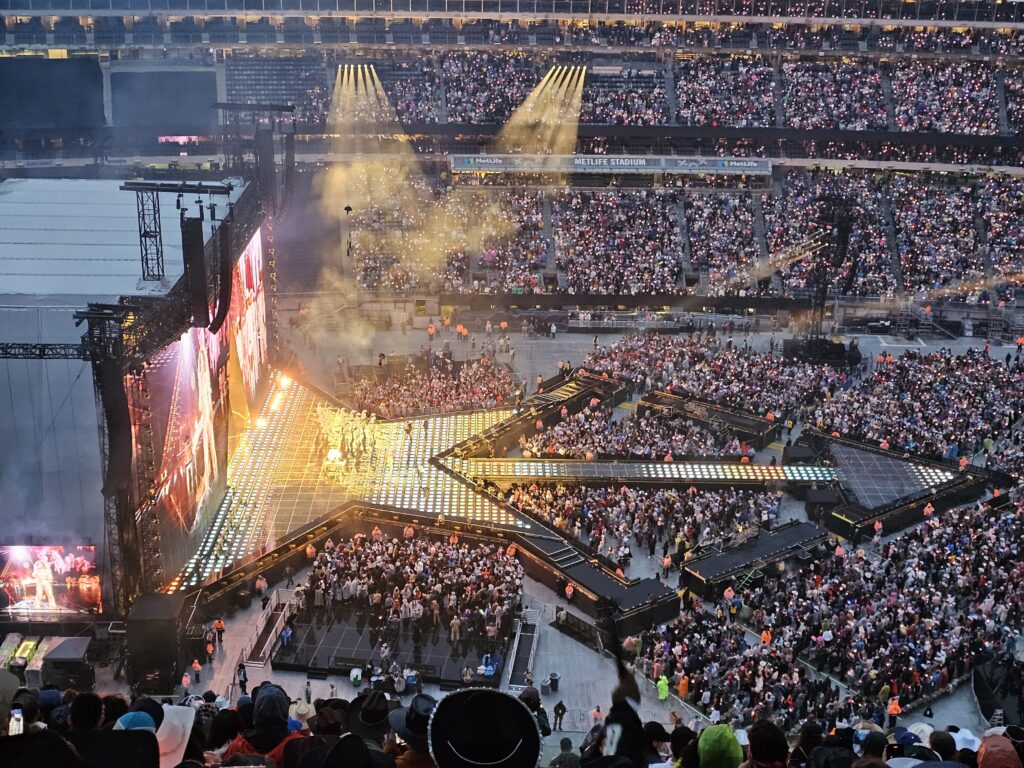It is my seventh time in New York, and this time around, despite it being May, the weather is really cold and rainy. I have seen most of the tourist sights in the city by now, so it isn’t easy to find something interesting!
Looking for tours in New York City?
New York City Pass, that let’s you enter multiple places by buying just one ticket
It’s Wednesday lunchtime, and as we approach New York from New Jersey by bus, the skyline looks particularly ominous.
As we enter the eternally congested city, my Canadian colleagues say, “If the weather improved just a little bit, it would be pretty good!”
I chuckle to myself—they’re optimistic. I’ve seen the weather forecast, and if it doesn’t get worse, that would already be excellent!
Unfortunately, just as the bus stops to drop us off a block and a half from the hotel—because it can’t get any closer—it starts to rain.
The forecast was spot on: it’s 9°C (48°F), and the only thing saving me from getting completely soaked are the canopies above the entrances of the many nearby theaters.
Carrying two bags, I run after a German colleague because I know that about 40 more colleagues are behind us, and it’s clear the hotel check-in line will get long fast if I don’t hurry.
There’s only one official meeting left on this last leg of the business trip; the rest is free time that we can each spend as we like.
Since this is my seventh time in New York, while most of the others are here for the first time, I know we won’t be spending much time together—our interests are too different.
The only plan I’ve made is to go for afternoon tea the next day with Mel, a colleague from Australia.
A Fancy Hotel
The sprint with the bags pays off—there are only a few people ahead of me in line, but soon a huge crowd forms behind us.
Half an hour later, I step out of the hotel while most of them are still waiting to check in.
The hotel is very fancy—right by Times Square.
As soon as I enter my room, it’s clear that a big chunk of the $500-per-night rate is for the location.
The room itself is like a standard four-star hotel: two beds, a small coffee machine, iron, hairdryer—but at least it’s much more spacious than usual, not the size of a shoebox.
I had requested a room with a bathtub, though that turns out to be pretty pointless—it barely reaches above my ankles, following typical American fashion.
In over a dozen visits to this country, I’ve never seen the deep bathtubs we’re used to back home.
Even the coffee setup is uniquely local—despite the room’s price, the coffee must be drunk from paper cups.
I’ve already booked the next night outside the city. My Croatian colleagues are moving two blocks down the street to a cheaper hotel, and a colleague living in Saudi Arabia later texts me that he planned to extend his stay at this hotel but was quoted $2700 for four nights. That’s not just expensive—it’s ridiculously expensive.
Those who didn’t request a bathtub apparently got rooms with a view of Times Square, while mine faces the rooftops of other buildings. I don’t plan to spend much time in the room, even though it’s tempting—I want to take full advantage of being in the city!
There’s another surprise at check-in—a $40 voucher that supposedly covers the “destination fee.”
This is a charge added on top of the public room rate—not all NYC hotels have it, but many do. It’s often presented as a kind of city tax, though it’s not exactly that.
Hotels collect this fee to cover higher maintenance costs, and in return, they offer “benefits” you only find out about at check-in. Here, it can be used for a free tour (you can choose from several) or room-service breakfast, which I opt for the next morning.
To my surprise, though, $13 is still charged to my credit card. Pancakes, juice, yogurt, and tea—$40 wasn’t enough? One must also remember that in this country, tipping is expected—even for room service—and the minimum suggested amount is often 18–20%. And on top of that, there’s a $6 delivery charge anyway. The food comes in a paper bag, in disposable containers. There’s no trace of the experience I had in Washington, where a cart was wheeled into the room and a large metal cloche was dramatically lifted.
I’m disappointed—would’ve been better off grabbing breakfast at any café on the street! Just as I put the bags on the table and continue getting dressed, a staff member knocks again—he had accidentally left someone else’s toothbrushes in my bag. Not a promising start!
Times Square Characters and the Post Office
Before heading out, I unpack and put on all three sweaters I brought.
I truly didn’t expect such cold weather at the beginning of summer and am very glad I tossed in a windbreaker at the last minute. I do feel bad for my shoes though—my new, light gray suede sneakers definitely won’t look fresh after walking in weather like this.
Before I even step fully outside, the strong smell hits me through the hotel’s revolving doors—marijuana, which has been legal here since 2021.
Where the city used to smell like roasted chestnuts or hot dog stands, now it’s mostly weed in the air.
The hotel really is right at Times Square—the tourist mecca that every visitor to New York passes through.
Oddly enough, it’s unusually empty at lunchtime, with only a few of the usual characters around.
Street vendors are selling hats—a win, given the unseasonably cold weather—clearing out leftover winter stock. You can take a photo in the square with a rotating camera against the flashing billboard backdrop; enthusiastic hustlers offer this experience to every passerby. Nearby, a man in cowboy boots, a hat, and only underwear with the label Naked Cowboy strums his guitar.
Close to the Times Square police station, a group of young men in thin white sailor uniforms walks by.
Apparently, they’re so hardened by sea winds that they don’t even consider layering up in this weather.
It reminds me of last year’s visit—when the day after I left, a snowstorm hit and the internet was flooded with photos of a snow-covered city. This time it’s just cold—and just rainy.
My first stop is the post office—during my earlier time in Boston, I never managed to buy stamps.
I’m surprised by the long line, which moves very slowly—only one window is open.
I spot self-service machines in the corner and decide to take the risk of losing my spot in line.
I fiddle a bit with the ATM-style machine, and after a moment it spits out four stickers, each costing $1.65—the international letter rate from the U.S.
Half the strip is a QR code, no pretty flowers or butterflies or even a flag—just white space.
Since there’s not enough room on the postcard, I fold the strip and tear off the blank part. Hopefully they’ll get delivered!
Luckily, a few weeks later, recipients confirm the postcards did arrive.
After the post office, I walk past the famous Grand Central Terminal, opened in 1913 after ten years of construction—one of New York’s most iconic landmarks. TV and movie lovers will recognize scenes from Men in Black, Gossip Girl, and countless others filmed right here. Nothing is being filmed today, but I do see a man in a pink cowboy hat walk past, followed shortly by a guy with a plastic lightsaber from Star Wars. In New York, you can truly feel free to be whoever you are.
The Morgan Library
Before long, I arrive at the main place I want to see on this trip — The Morgan Library, the private library of financier John Pierpont Morgan. The building, completed in 1906, houses unique books, manuscripts, letters, and works of art. I actually discovered this place thanks to artificial intelligence — before the trip, I spent a long time researching what else I could do in the city when it’s pouring rain, since I’ve already seen all the major tourist spots multiple times.
Along with a few useless suggestions for museums that had long been closed, I stumbled upon this one — and this time, it was a bullseye!
I worry slightly that the place will be crowded with other people trying to escape the rain, but fortunately, it’s not so bad. Not empty, of course. You can buy tickets with a timed entry slot online, which likely means you should plan ahead on other days, but I manage to get one at the counter, paying $25 — no line at the ticket desk or the coat check.
Unfortunately, the library’s garden is only open on Fridays and weekends, but given the weather, I’m not too disappointed and would rather be indoors anyway.
Inside, you’d think the building was much older — not just 120 years. Designed by architect Charles Follen McKim, it’s a stunning example of classical architecture. At times, the interiors feel like a medieval abbey somewhere in Switzerland; at others, like a miniature replica of St. Peter’s Basilica in the Vatican.
Walking through Morgan’s study, I pick up a booklet placed in the corner — printed on slightly heavier paper and meant to be used in the room and returned for other visitors. I learn that the bright red wall fabric is a reproduction — the original was ruined by Morgan’s habit of smoking in the room. The brown wooden paneling on the ceilings, stained glass windows, and vivid red walls give me a slightly oppressive feeling, so I move on, looking for the library’s main hall.
It’s easy to find by following the crowd. Most visitors are here, not in the library’s other floors, where you can see things like lace-bound books and cut-out illustrations from medieval illuminated manuscripts — a past trend where images were kept and the centuries-old text discarded.
In the library’s main hall are the three most famous pieces in the collection: an original Gutenberg Bible, the Stavelot Triptych (from around 1156), and the Lindau Gospels, whose back cover was made around 780–800 and is the only known surviving example of an early insular metal gospel book cover.
I sit for a moment on one of the sofas in the middle of the room and take in the surroundings. There’s chatter, excitement, curiosity — the room feels much livelier than you’d expect for a library. Of course, it’s now a museum, not a public reading space.
Wearing multiple layers of sweaters, I start to feel overheated. I’ve seen the main highlights, and it’s almost time to move on, so I slowly begin making my way out. I take an unplanned detour into the gift shop, which — for once — you don’t have to pass through to exit.
The first thing I notice is small handbags. Really?! Yes — the info card says they’re from India. I have the exact same bag, bought from a street vendor in New Delhi. Though these seem more neatly sewn, the design is unmistakably identical. Alongside the handbags are socks with famous literary characters, elegant napkins with tigers and flowers, tea blends for book lovers, and beautifully published editions you just want to hold. I already own an Anne of Green Gables set, but here there’s a particularly lovely edition with gilded edges. I resist — but it’s not easy.
A Cold Evening
I continue slowly toward the hotel. I pass by the massive New York Public Library building I visited last year, walking through Bryant Park. From afar, the greenery looks lovely, but up close I notice the plants aren’t in the ground — hundreds of pots have simply been placed on the earth. Poor soil? Are they struggling? The black pots look odd up close.
Passing through the park, I spot another street vendor stall tucked behind scaffolding. The setup suggests this business might not be entirely legal, but clearly, there’s demand — they’re selling umbrellas and ponchos.
As I walk, I’m reminded of the New York Tourist Bingo jokes — rows and columns of bizarre sights and experiences one is bound to encounter in this city. Over the years, I could shout “bingo!” — I’ve seen it all: dog walkers with ten well-behaved dogs (actually walking them, not being dragged along), the fashion-forward characters who make you wonder if you’re looking at a style icon or signs of a mental health issue. People loudly talking to themselves — it’s not guaranteed they have earbuds in. Puddles of urine at street corners and sidewalks, piles of feces nearby, and homeless people sleeping right next to them. Of course, the rats in the subway. In this city of eight million, there’s the dazzling side we’ve seen in movies and shows — the experiences we want to repeat — but also the harsh reality that’s never too far away.
There’s one last official event with colleagues at an outdoor café by the East River. I’ve layered the same three sweaters again, but it’s not enough — it starts to rain, the wind is howling, and the plastic palm trees around the café rattle in the gusts. I ask for a hot drink, or at least some hot water — I always carry my own tea — but unfortunately, this café doesn’t serve anything hot. Shivering, I eat a portion of fries and a couple of tacos, and after an hour (and seeing others start to leave), I head toward Wall Street guilt-free.
I walk past the hotel I stayed at last time and head to a discount outlet store near the stock exchange. Last time, I heard Latvian spoken right at the entrance — confirming Latvians really are everywhere! This time, no Latvians, but I do overhear a conversation between a salesperson and a customer asking about gloves. “Sorry, we don’t have any. It’s not the season — no one expected it to be this cold!”
After half an hour in the store, I finally feel warm. It’s tempting to bring everything home — a famous underwear set for about $10, six lovely kitchen towels for just $5. When I get into the Uber, the driver comments on how interesting it is that tourists still shop in brick-and-mortar stores. Then she corrects herself, realizing “tourist” might sound offensive, and switches to “visitors.” She’s been shopping online only since the pandemic began. I laugh and confirm, yes, I’m a tourist — and though I often order things to be delivered to hotels, there are still some things I like picking out in person.
The city is dark, and thankfully the traffic has cleared. The ride back to the hotel is smooth. For a moment, I spot a tall ship with broken masts docked along the riverbank. It’s the Mexican vessel Cuauhtémoc, which crashed into a bridge a few weeks ago, causing two deaths and several injuries. There it stands in the dark, near the site of the accident.
Back at the hotel, I decide to visit the rooftop restaurant with its rotating platform. The view doesn’t live up to expectations, but at least I’ve seen it. On the way up, I overhear a conversation between an American couple — like me, they’re wearing everything they brought. On the small elevator screen, the weather forecast pops up, and the man points to it, saying, “And we paid $1,700 per person for this!” They shake their heads and look deeply miserable. Sadly, that’s how it goes sometimes.
Hop-on Hop-off tour
The next morning begins with dropping my bags off at the hotel’s luggage hold. I decide to take one of the included free tours — a hop-on, hop-off bus ride around Manhattan. Although I’ve seen everything on the route before, the weather is just as nasty as the day before, and the nearby museums I haven’t already visited are few — so why not take a dry, lazy ride for a change?
The brochure says the tour lasts 90 minutes. I have afternoon tea with Mel scheduled a few hours later, so this seems like a perfect, low-effort activity — maybe I’ll see something new, and at least I’ll stay dry. Apparently, others have the same idea — the bus’s lower deck is packed.
I plug in the headphones and start listening to the audio guide. After the first few stops, it becomes clear the system isn’t working properly — some segments repeat several times, others cut off mid-sentence. We seem to be completing the route faster than the guide can keep up. From the lower level, the view is poor, and mostly we’re just stuck in traffic.
Unfortunately, when the supposed 90 minutes are almost up, we’re nowhere near the start — in fact, we’re at the furthest point from where I need to be. I start to worry — the tea has a set reservation time and lasts only 90 minutes, and Mel will be waiting. Meanwhile, traffic worsens by the minute — each stop now takes over ten minutes to reach. I jump off the bus and head for the subway.
I hadn’t planned to use the subway this trip — usually, it’s the fastest way around NYC — but here we go. For the first time ever, I fail to buy a ticket. The station only has self-service machines, which look like they haven’t been updated in decades, and none of them accept any of my three payment cards. They freeze up at the ZIP code prompt. I try entering just zeros, or my actual ZIP with an extra zero at the end — no luck.
I have cash, so I insert a $20 bill. Then the machine says it can’t give change — would I like to buy another ticket? No, thank you.
Time’s up. Walking to the next stop isn’t an option, and taking an Uber would take just as long as staying on the bus. I surface again near the station and spot a hot dog stand. I ask the vendor if he can break my bill. He finishes a customer’s order, opens his wallet stuffed with cash, and gives me change in ones and fives. Perfect!
Naturally, a few trains pass me by during this whole process. When I finally get on the train and check how far I have to go, I see a notification from Google Maps — you can also pay for the subway with your phone using Wallet. At least I’ll know that for next time!
The subway car, like the station, has seen better days. It seems to be one of the few that still doesn’t have a display showing the next stop, so I follow along on my phone. I message Mel that I’ll be 10 minutes late.
Suddenly, the train stops in the tunnel. A crackling noise — like rustling newspaper — comes over the speaker, apparently the driver making an announcement, but I can’t make out a word. Five minutes go by. Then ten. I can’t even update Mel because there’s no signal underground.
Finally, the train moves. Another round of “New York Bingo” — stuck in a subway tunnel. Luckily, not for too long. After running along the edge of Central Park, I finally arrive at The Plaza Hotel — where I’ll enjoy a refined afternoon tea.
“Home Alone” Tea
If not for Mela, my afternoon tea reservation might have vanished into thin air, but since my colleague arrives on time, our table is ready. In the meantime, the woman has familiarized herself with the menu and already gotten hold of the hotel’s special tea blend. We are at The Plaza Hotel, where rooms cost about $1000 a night, in the elegant Palm Court lobby bar. This hotel is widely known as the place where Kevin stayed in Home Alone and where he met Donald Trump in the lobby.
Afternoon tea has become something of a tradition for me when I travel. One version of the origin of afternoon tea says that it was invented by Anna, the seventh Duchess of Bedford (a friend of Queen Victoria), around 1840 in England. At that time, dinner was served very late, around 8 p.m., leaving a large gap between lunch and dinner. The Duchess often felt hungry around 4 p.m. and asked for a tray of tea, bread and butter, and pastries to be brought to her room. This became a habit, and later she began inviting friends to join her for this late afternoon meal. Other versions claim the tradition is actually quite modern, with the historical element somewhat embellished to create an aura of exclusivity and antiquity. Either way, afternoon tea is often one of the most affordable ways to dine in otherwise exclusive locations with renowned chefs. These teas are often served in the lobby bars of five-star hotels.
I booked our table the day before through the OpenTable platform, as it looked like many people had the same idea during this rainy weather. The room is quite full, and there are many who wish to experience the tea.
After rushing in, I sit down next to Mela, and she laughs, telling me to catch my breath. Everything’s fine now — I’ve made it, and I can enjoy the experience! This is about my twentieth afternoon tea, but for Mela it’s her first, so I explain what’s going to happen. First, we both have to choose which tea offering we want. The meal costs between $125 and $305 per person, with three adult menus and one children’s menu available. Mela chooses the cheapest one, at $125, and to avoid getting the same, I choose the next one up, at $145. In the end, the biggest difference is that my sandwiches have caviar sprinkled on top, and Mela’s don’t.
The offering includes nearly everything required for a proper afternoon tea experience – a variety of savory finger sandwiches (with cucumber sandwiches taking the spotlight), just as many sweet pastries (too many to remember), and two scones each to eat with jam and cream. Instead of the usual clotted cream, they serve lemon curd this time, which turns out to be very tasty. The tea is unlimited, but surprisingly underwhelming — Mela’s tastes like Christmas tea, while my lavender oolong smells more like a bathroom air freshener. The sandwiches, however, are excellent, and the conversations even better!
The next two hours fly by. Mela and I have known each other for seven years but have only met in person once — seven years ago — keeping in touch virtually all this time. We share similar tastes in movies and books, a similar worldview, and the conversation never stops. Though our table is reserved for only an hour and a half — and I’ve already lost about 30 minutes by being late — no one asks us to leave after the time is up. Later in the afternoon, the bar serves different snacks and drinks, which apparently aren’t in such high demand that our table is urgently needed. After two hours, they bring us two boxes and two bags without being asked, saying we can pack up whatever’s left whenever we’re ready. The hint is clear. We ask for the bill, which comes with postcards — we can send them anywhere for free. At first, we’re given one each, but when we ask, the waitress kindly brings two more.
Mela soon has to rush to her next destination, and I do too. We take a photo together by the massive flower arrangement in the lobby, admire the rest of the hotel’s interiors, and it’s time to move on. I have a windbreaker, Mela doesn’t have anything, so I give her my rain poncho. Mela is thrilled by the tea experience and promises to find something similar in Sydney. For now, Sydney is still just on my dream list.
Journey to New Jersey
If not for the two bags I’m carrying, I would definitely take the train, but remembering past experiences in New York subway stations with no elevators, this time I choose Uber to get to New Jersey. When I greet the driver, we quickly realize we both speak Russian. Rustam is from Uzbekistan and has lived and worked in New York for three years. We spend the next hour and a half — I’ve caught peak rush hour — talking.
He used to live in Sweden and knows where Latvia is, having visited several times. He tells me about someone named Sergey who once offered him a way to get a residence permit for €3000. Of that, €700 would go to a Latvian woman (the “wife”), and the rest to the “organizer.” Rustam says he regrets not accepting the offer. He already had a real wife at the time and said, as a family man, he wouldn’t marry another woman, even just on paper. But now it’s too late. Since moving to the U.S., he hasn’t seen his wife and two kids. He doesn’t risk leaving, fearing he won’t be allowed back, as he puts it — he has no legal status here. His wife and children were denied visas, so they can’t visit either. When I ask him to compare working in Sweden and the U.S., he says you can earn more in the U.S., but it was safer in Sweden. He doesn’t take orders after 9 p.m. anymore. When I ask why, he says, “Well, all sorts of illegals have arrived here lately.” As he says this, it doesn’t even occur to him that he’s in the exact same situation himself.
Concert
I’m heading to New Jersey for one reason — there’s a Beyoncé concert, the first of five in the New York area. I booked a hotel just a ten-minute drive from the stadium to keep transport costs down. When I get into the next Uber, right after leaving my bags in the hotel room, I’m met with an unpleasant surprise — the driver, upon hearing I’m going to the concert, flatly refuses to take me and tells me to get out. He doesn’t want to sit in traffic near the venue. I get out and see in the app — the next car won’t be available for 20 minutes. For this ride, which started and ended in front of the hotel, I was charged almost $10 (which led to three weeks of back-and-forth with Uber to get a refund).
Luckily, I notice a sign in the hotel — they offer an organized shuttle. At $30, it’s actually cheaper since I’m traveling alone. I quickly buy a ticket, hop in the van, and in ten minutes, I’m there. The driver clearly does this often — he crosses solid lines, bypasses traffic, and drops me and seven others off right in front of the stadium in no time. From there, it’s less than a ten-minute walk to the venue.
Attending the concert gives me a chance to observe how such events are organized abroad. In the U.S., even if a concert is sold out, you can still legally buy tickets in the resale market — either from people who can’t attend or from scalpers. Tickets can be resold legally through the official platform, but the buyer pays a hefty commission. A seat in the last row of the stadium, listed for $88, actually costs $140. The tickets only work in the Wallet or Ticketmaster apps (the latter not available in our region), and don’t show any barcodes. At the entrance, you must scan your phone. No phone, no concert. There are strict rules on what you can bring — umbrellas are banned, and bags must be no larger than a sizeable wallet, unless they’re clear plastic. At the entrance are huge bins, mostly full of umbrellas, but a few purses too.
Thankfully, I checked info about the stadium beforehand. It holds nearly 90,000 people. Across the five concerts, Beyoncé will perform for 250,000 fans. But the stadium has no roof! I gave my only poncho to Mela, and onsite they cost $15. Since the concert has already cost more than I’d like, I decide my jacket will have to do. If I get too cold, I’ll leave early. The return shuttle has a set time, but I’ll figure something out.
I watch the other concertgoers. They’ve prepared carefully — an American colleague even asked what I’d be wearing. Almost everyone has a cowboy hat or boots (the tour is named Cowboy Carter), many with matching denim outfits. Too bad the weather hides some of the great outfits under rain gear.
I don’t want to wait in the rain, so I spend the time in the stadium’s shopping areas on each level. I grab a hot dog — ketchup and mustard thrown on the sausage in the wrapper — and some hot cocoa. The U.S. isn’t a tea country, so I’m just glad there’s something other than coffee. In this sheltered spot, with a chance to wash my hands in hot water, I’m fairly comfortable.
Almost exactly an hour after the stated start time, the concert begins and everyone rushes into the stadium. It’s drizzling. Luckily, there’s a small overhang above the last rows that protects me from the straight-down rain. Below, it looks much wetter, and during the show, the floor is wiped regularly — these floors also serve as screens for visual effects. I’m impressed by the dancers who manage to stay balanced on such a slippery surface!
From this height, I can see the big picture, and some detail on the side screen, but the view isn’t great. I mostly watch through my phone camera, zoomed in 10x. A few songs in, I notice movement to the left — people are being relocated. Then, a stadium staff member approaches me: “How many of you?” “Just one!” I say. He hands me a slip of paper — a new ticket! I follow the others. I was in the third tier, now I’m in the second tier, front row — almost two full levels lower. These seats definitely cost several times more. Finally, the rain stops and it’s just chilly. To reach the new seats, though, I have to descend to the stadium’s base and go back up via escalator. They check tickets again. Someone is already in my seat, but the one next to it is free. No one sits much anyway.
Later, more people arrive. Whether they were also moved or just snuck in is unclear. Around me are true fans, singing along to every word, mimicking choreography, filming the entire show, or smoking weed during breaks. The concert lasts 2 hours and 45 minutes, with multiple costume changes (including the famous LED-lit dress), countless dance moves, a mechanical bull, an improvised truck and convertible circling the stage, and even a horseshoe-shaped swing the singer rides above the crowd. When the last song ends, lights come on. No encore. Everyone leaves.
Immediately, I rush to the parking lot, where at exactly 11 p.m. the shuttle awaits. I move quickly through the crowd, past dozens of men offering rides, and through a tunnel where Beyoncé T-shirts are sold for a few bucks — compared to $50 and up inside. Thankfully, I make it five minutes before departure, board the van, and savor the warm air blowing from the heaters. As usual after concerts, my ears feel muffled. A few minutes later, the van is full, and the driver tells the remaining folks he’ll return soon.
Mill Creek Marsh Boardwalk
The next morning, I have to head to the airport around noon, but the morning is free. I go to breakfast at a relaxed pace, eating a waffle and yogurt among other pajama-clad guests. I’ve found out there’s a marsh trail nearby, with several shops next to it. I remember that we passed by there in the shuttle the day before, but I didn’t notice any sidewalks. The hotel front desk confirms that there should be a sidewalk, though the distance is fairly long. I also spot a hotel guest carrying a shopping bag with a store logo and ask for her advice. “It’s quite far, like a 15-minute walk, but there is a path!” she says. The idea of what’s considered “far” really differs in this car-centric country.
Luckily, both people I asked are right about the pedestrian path — it’s only on one side of the street, but it’s there. I walk past the store’s parking lot, and tucked behind it is the entrance to the Mill Creek Marsh nature trail. Time to see what marshes look like here! The nature trail was developed relatively recently — the area was declared a protected site in 1996 and improved two years later, not only by building pathways and removing invasive plants (replacing them with native species), but also by restoring the natural tidal cycle.
At the time of my visit, the water level is very low, and I can see the stumps of long-dead cypress trees. It’s a real birdwatcher’s paradise — wherever you look or listen, there are chirpers all around. On the way back, I see a couple in camouflage clothing with serious camera equipment — clearly, I’m not the only one who thinks this place is worth seeing. It’s lightly drizzling during my visit, but that doesn’t take away from the experience of this little pocket of nature. In the distance, the New York skyline is visible; the hum of the highway is ever-present. I’m almost completely alone on the trail, encountering only one man walking his dog. Later, I spot a residential complex across the water. The view from there must be great — though I imagine the mosquito population here numbers in the millions.
Time to Say Goodbye
On my way back, I do stop by the store whose parking lot I walked through earlier. It’s the same brand from last year’s collection, and there are two more stores nearby. The prices are so good it’s tempting to grab everything. In the end, I buy a pair of jeans from a favorite brand for $15 and two T-shirts for $13. The product selection is a bit different from what I saw in New York — many more notebooks with Psalm quotes and rosaries included. It seems that fewer “picked-over” designer items are here, and the selection is actually quite good.
Still, it’s obvious that shoplifters have been here too. Many clothing items are missing price tags or parts of bundled sets — out of a five-piece set, only four items are available. Staff then spend extra time figuring out a similar item to use for price calculation.
My ride to the airport is with an Uber driver named Oleksandr. As soon as I see his name, I ask, “Are you from Ukraine?” Yes! He’s genuinely happy we can speak, saying he doesn’t speak English as well as he’d like. I tell him about my relatives in Mariupol and the Volyn region. He shares how he and his wife left the country on the very first day of the war, reaching the U.S. through France and Mexico. They crossed the final border on foot. They only made it here because their daughter has lived in New Jersey for many years — otherwise, he says, he would’ve preferred to stay in Europe, as the mentality there is closer to home. But at least his daughter helped him sort out the paperwork and register everywhere necessary, so now he can legally work here.
At his age, he says, he’s no longer up for heavy lifting, but at least he can drive and transport passengers. He says their refugee status in the U.S. is complicated — although they are officially refugees, the new president could revoke that status at any moment. It’s tough living in uncertainty, and he’s considering moving to Ecuador — he’s heard it’s easier to settle there. I can only confirm that, since I’ve heard similar stories from my relatives.
We talk about the kind of media people consume and how that shapes their views. Oleksandr admits that even in the U.S., he sees clearly why so many people have mixed feelings about the war in Ukraine.
The rest of the ride, we talk about life in the U.S., which stores have cheaper groceries, and how they mostly cook at home since restaurant food is often unhealthy. What he wants most is to go home, but his city is now right on the front line, so that’s out of the question.
When we arrive at the airport, we hug goodbye. I wish him the best — whether that means succeeding here, returning home, or, if nothing else, making it to Ecuador. This twenty-minute ride is yet another reminder of how close war really is. How it impacts millions of lives. A few days later, I receive news — both my cousin’s husband and my mother’s friend’s husband have been drafted into the Ukrainian army.
Looking for tours in New York City?
New York City Pass, that let’s you enter multiple places by buying just one ticket


